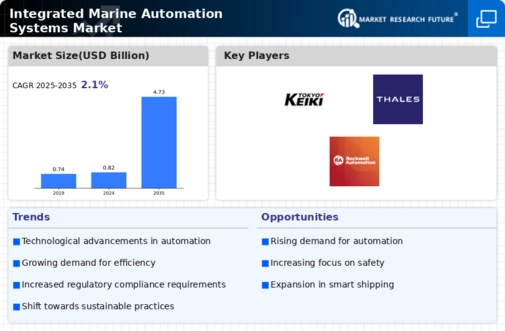Market Share
Integrated Marine Automation System Market Share Analysis
The Integrated Marine Automation System market, a key player in the maritime industry responsible for automating various shipboard tasks and systems, deploys strategic market share positioning approaches to excel in its competitive landscape. Companies within this sector employ a range of strategies to distinguish themselves and secure a significant share of the market.
A fundamental strategy in the Integrated Marine Automation System market involves continuous technological innovation. Companies invest heavily in research and development to introduce cutting-edge automation solutions that enhance the efficiency, safety, and operational capabilities of marine vessels. Innovations may include advanced control systems, integrated navigation technologies, and real-time monitoring capabilities. By offering state-of-the-art solutions, companies aim to attract a broader customer base and position themselves as leaders in the market. Staying at the forefront of technological advancements is crucial for maintaining a competitive edge in this dynamic industry.
Strategic partnerships and collaborations play a pivotal role in market share positioning within the Integrated Marine Automation System sector. Companies often form alliances with shipbuilders, naval architects, or other key stakeholders in the maritime industry to create integrated and interoperable solutions. These collaborations facilitate the development of comprehensive automation systems that seamlessly integrate with different types of vessels. By aligning with industry leaders, companies can broaden their market reach, tap into established distribution channels, and contribute to the establishment of industry standards for marine automation.
Market segmentation is another crucial aspect of market share positioning in the Integrated Marine Automation System market. Companies recognize the diverse needs of different types of vessels, such as commercial ships, offshore platforms, and naval vessels. Tailoring automation solutions to suit specific applications allows companies to cater to the unique demands of diverse customer segments. This targeted approach enables companies to capture a larger share of the overall market by providing specialized systems that align with the specific requirements of their customers.
A robust marketing and branding strategy are essential for establishing a strong market presence in the Integrated Marine Automation System sector. Clear communication of the benefits, reliability, and efficiency gains associated with integrated marine automation solutions is crucial for building trust among shipowners and operators. Companies engage in marketing campaigns, participate in maritime industry events, and collaborate with shipbuilders to showcase the advantages of their automation systems. A strong brand presence not only attracts new customers but also reinforces confidence and reliability, contributing to sustained market share growth.
Pricing strategies play a pivotal role in market share positioning within the Integrated Marine Automation System market. Companies must carefully determine pricing structures that reflect the value of their automation solutions while remaining competitive in the market. Pricing considerations may involve factors such as the complexity of the system, the size of the vessel, and the overall performance of the automation technology. Some companies adopt a cost-effective approach, aiming to provide affordable solutions, while others position themselves as premium providers, offering advanced features and capabilities at a higher price point. The chosen pricing strategy should align with the overall market positioning and value proposition to effectively attract and retain a diverse customer base.






Leave a Comment